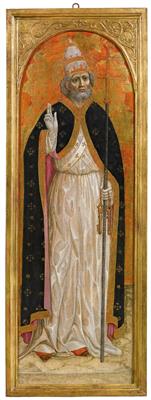Venetian School, 15th Century

Saint Gregory the Great,
tempera on panel, gold ground, 97.5 x 35 cm, framed
The present work is stylistic close to works of Antonio Vivarini who became prominent in Venetian painting in the 1440s, producing many joint works with his brother-in-law Giovanni d’Alemagna. Antonio also often collaborated with his younger brother Bartolomeo Vivarini (see lot 10). The family dynasty of painters remained important until the death of Antonio’s son Alvise Vivarini in 1502. Giovanni d’Alemagna must have been of German origin, but he was completely integrated into the family workshop, and art historians have attributed to him supposedly German elements in his joint works with Antonio.
Saint Gregory, known as Gregory the Great, was Pope Gregory I from 590 until his death in 604. He is known for his important contributions to the Liturgy of the Mass and Office. He is one of the four great Doctors of the Latin Church. A senator’s son and himself the Prefect of Rome at 30, Gregory entered the monastic life but soon returned to active public life. Although he was the first pope from a monastic background, his prior political experiences may have helped him to be a talented administrator, who successfully established papal supremacy. He was stronger than the emperors of declining Rome and challenged the power of the Patriach of Constantinople in the battle between East and West. Gregory regained papal authority in Spain and France, and sent missionaries to England. The realignment of barbarian allegiance to Rome from their Arian Christian alliances shaped medieval Europe. Gregory saw Franks, Lombards and Visigoths align with Rome in religion.
Throughout the Middle Ages he was known as the Father of Christian Worship because of his exceptional efforts in revising the Roman worship of his day. His contributions to the development of the Liturgy is still in use in the Byzantine Rite. He is the patron saint of musicians, singers, students, and teachers.
19.04.2016 - 18:00
- Stima:
-
EUR 40.000,- a EUR 60.000,-
Venetian School, 15th Century
Saint Gregory the Great,
tempera on panel, gold ground, 97.5 x 35 cm, framed
The present work is stylistic close to works of Antonio Vivarini who became prominent in Venetian painting in the 1440s, producing many joint works with his brother-in-law Giovanni d’Alemagna. Antonio also often collaborated with his younger brother Bartolomeo Vivarini (see lot 10). The family dynasty of painters remained important until the death of Antonio’s son Alvise Vivarini in 1502. Giovanni d’Alemagna must have been of German origin, but he was completely integrated into the family workshop, and art historians have attributed to him supposedly German elements in his joint works with Antonio.
Saint Gregory, known as Gregory the Great, was Pope Gregory I from 590 until his death in 604. He is known for his important contributions to the Liturgy of the Mass and Office. He is one of the four great Doctors of the Latin Church. A senator’s son and himself the Prefect of Rome at 30, Gregory entered the monastic life but soon returned to active public life. Although he was the first pope from a monastic background, his prior political experiences may have helped him to be a talented administrator, who successfully established papal supremacy. He was stronger than the emperors of declining Rome and challenged the power of the Patriach of Constantinople in the battle between East and West. Gregory regained papal authority in Spain and France, and sent missionaries to England. The realignment of barbarian allegiance to Rome from their Arian Christian alliances shaped medieval Europe. Gregory saw Franks, Lombards and Visigoths align with Rome in religion.
Throughout the Middle Ages he was known as the Father of Christian Worship because of his exceptional efforts in revising the Roman worship of his day. His contributions to the development of the Liturgy is still in use in the Byzantine Rite. He is the patron saint of musicians, singers, students, and teachers.
|
Hotline dell'acquirente
lun-ven: 10.00 - 17.00
old.masters@dorotheum.at +43 1 515 60 403 |
| Asta: | Dipinti antichi |
| Tipo d'asta: | Asta in sala |
| Data: | 19.04.2016 - 18:00 |
| Luogo dell'asta: | Wien | Palais Dorotheum |
| Esposizione: | 09.04. - 19.04.2016 |
